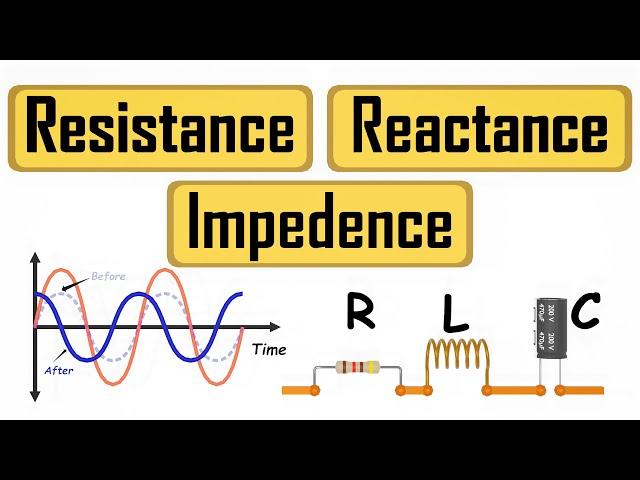Комментарии:

People is wrong about alternating current.... Don't go in back... Vibrate... Open down faster.... They need to change about...🫵🧐
Ответить
In a DC circuit, current flow is negative to positive.
Ответить
I still coundnt understand inductive reactance
Ответить
Fantastic, thank you very much.
Ответить
Damn you deserve the whole world.
Ответить
Wowwwww you are so cool, thanks so much, is great explanation.
Ответить
Good video. Could you tell me what program do you use for the simulations, thanks. A tittle for your next video could be, capacitive reactance, inductive reactance and RESONANCE. God bless you ! Thanks.
Ответить
THANK YOUUU !!
Ответить
Why is this narrated as a true-crime drama?
Ответить
Que vídeo maravilhoso
Ответить
Finally a video I understand bless you brother
Ответить
👏👏👏👏
Ответить
In dc current, there is a flow of current to charge the capacitor if it was initially uncharged. And, even in an inductor which is connected across a dc source, it initially opposes the rise in current. The graphs shown in the video are not accurate
Ответить
fabulous
Ответить
Amazing work! The level of detail in your animations is incredible. Could you share what software you used to create such powerful visuals?
Ответить
Excellent job description is fantastic ❤❤❤❤❤
Ответить
Nice video, keep it up, thank you :)
Ответить
You really could have just explained how capacitors and inductors work.
Ответить
Prof MAD You Are The Boss Of All Explainers In Universe ❤
Ответить
That's a negative on the AI voice I would imagine if this was also written by AI.
Ответить
thanks
Ответить
Explanation and depth of the subject is excellent.
Ответить
Great video! Had not seen the membrane analogy before.
Ответить
most cringe voice on the internet
Ответить
Ohh Im diggin this, thanks a lot Prof!
Ответить
Very Helpful. Thank you !
Ответить
Greatest explanation I have ever seen
Ответить
Please do a video on the same analogy of water for 3 phase power.
Ответить
Would have been nice to close with the explanation of recurring tems like "high impedance," "low impedance," and "impedance matching "; which you'll often hear about: i suggest you Google those for a good closing thought on these important concepts.
Ответить
Excellent
Ответить
Brilliant explanation! Loads of thanks!:D
Ответить
My favorite is Reluctance: "Aw do I really have to pass this current? Oh well, OK but I won't be held responsible if there's an overload"
Ответить
amazing
Ответить
Being an electrical undergrad, I appreciate your analogy of inductor and capacitor. The whole duration of this video never had an breaking point of the understanding.
Ответить
May I seek to know from what you said, that current is constant in a D.c circuit please.
Is it a rule for all digital circuits with ICs and passive components ??

Nice video voice ND contents. What are the applications of these 4 terms R.I, R.C, and impedance
Ответить
I learned electronics the old fashioned way when current is illustrated as flowing from Negative to Positive. This new trend where current is being shown as flowing from Positive to negative is confusing to me. It doesn't make any sense. The whole thing is called ELECTRONics for a reason because it follows or manipulates the flow of electrons.
Ответить
Best video ever
Ответить
Resistance,impedance and reactance (R, Z and X) are all measured in the unit of Ohm. Thanks a lot for this video
Ответить
As a newbie to electronics as a hobby I am gaining so much knowledge and understanding on various topics I have watched. Thank you
Ответить
I so f*ing hate this voice, it's all over social media and now here as well.
Ответить
Excellent 👏
I am from El Salvador and I love theses videos 😉

The only criticism I have is that when discussing capacitive reactance, they mention “the water flow leads the force” and “the water flow must change before the force changes” - and this caused me confusion because obviously that’s impossible. What they should have said was “the water flow DIRECTION change” leads the force
Ответить
Can we check voltage across live capacitor when we apply DC voltage?
Ответить
Best circuit graphics I have ever seen!
Ответить
Not Reactance not Impedance.
It is Inductance, Capacitance.

Excellent Explanation Sir. It is one of the simplest explanation. I never seen such a good explanation
Ответить
Sir ur great and nice explanation.
Ответить
Bravo. Great teaching presentation.
Ответить
This video beats my lecturer in university.
Ответить

















